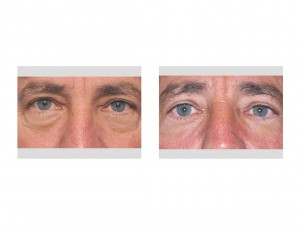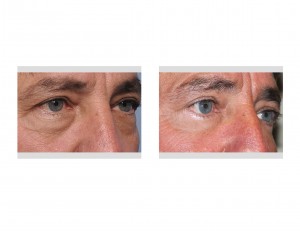Background: Aging affects all areas of the face but not more profoundly than the periorbital (eye) area. Because of the thin tissues of the eyelids, they are prone to display wrinkles, loose skin and lower eyelid bags even early in the aging process. Because most human conversation is done by looking in the eyes, and they are the first thing we usually look at in the mirror, aging changes in the eye are very noticeable and usually disturbing.
The male periorbital area ages just like that in females and responds equally well to blepharoplasty (eyelid tuck/lift) surgery. But there are several unique aspects of a male blepharoplasty. Men tolerate aging changes better than women and as a result they often appear later in the aging process with more profound eyelid tissue issues. The upper eyelids usually have significant hooding and the lower eyelids have bags. Usually the lower eyelid bags are of a bigger concern because they contribute more to a tired and aging look.
The aging lower eyelid bag is caused by a combination of herniated fat, excess skin and sometimes a lax or loose lower eyelid. The biggest anatomic contributor is the fat component. The fat is the result of a protrusion or displacement from its normal under the eyeball position. Normally held into position under the eyeball by ligaments between the eyelid and the bone, aging or a genetic weakness in them allows the fat to come forward creating the ‘bag effect’. This is known as a herniation, much like that of a defect in the abdominal wall.
Case Study: This 48 year-old male wanted to improve his tired looking lower eyes. He had fairly pronounced bags, loose skin and wrinkles. What bothered him the most were the protruding bags which was worse in the morning and after eating salty foods. He had a fair amount of hooding on the upper eyelids but this was not a concern to him.


Lower eyelid bags are an undesireable aging feature that no topical or laser therapy is going to improve. Even if they could produce a mild improvement in lower eyelid bags the male patient is usually interested in a more efficient and effective therapy. Lower blepharoplasty surgery is the most effective treatment known and the only question is whether it is done with a transcutaneous (outer eyelid incision) or a transconjunctival (inner eyelid incision) approach. This depends on how much loose lower eyelid skin is present.
Case Highlights:
1) One of the common aging concerns for the middle-aged male are lower eyebags.
2) Lower eyelid bags are the result of herniated fat from under the eyeball that sticks out beyond the lower orbital rim.
3) A transcutaneous lower blepharoplasty can very effectively remove herniated fat and loose skin from the lower eyelid, creating a less tired look.
Dr. Barry Eppley
Indianapolis, Indiana


